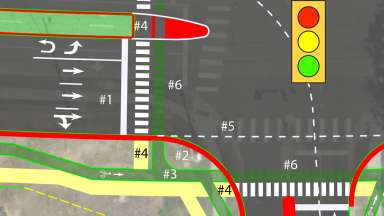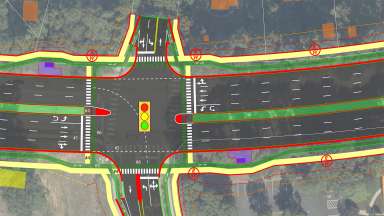Jump To:
What are Protected Intersections?
Protected Intersections, or Setback Intersections, use a variety of intersection treatments to provide people walking, biking, and driving dedicated paths through the intersection. The design creates shorter and simpler crossings, improves visibility, and reduces the likelihood of high-speed turns, resulting in a safer intersection for all users.
This style intersection is new to North Carolina. Raleigh will see its first one with the Blue Ridge Road Bike and Ped Project. That one will be at the Blue Ridge Road and Reedy Creek Road intersection.
How They Work
There are six main design features of a protected intersection.
- Setbacks between the motor vehicle lane and the bikeway, creates a clear sight distance allowing people in vehicles to clearly see people walking and biking.
- Corner islands extend the protected bike lanes and the sidewalks into the intersection. The islands separate people on bikes from vehicles, prevents vehicles from intruding on the bikeway and helps reduce the speed of turning vehicles.
- Bike queuing areas provide a space where a person on a bike can wait ahead of the crosswalk for a green signal or if they need to turn. This allows a shorter crossing distance and accommodates the natural positioning for a person on a bike.
- Pedestrian islands reduce the crossing distances and improve visibility by keeping the intersection clear. Wider islands support high volumes of people walking and biking, raising the capacity of the intersection. In some cases, islands can reduce the signal time needed for pedestrians to cross the street.
- Motorist waiting zones allows space between the vehicle lane and the crossbike for driver to wait before turning across the path of travel of people walking and biking.
- Separated bike and pedestrian crossing zones allow both cyclists and pedestrians to cross the street in their own designated paths.

